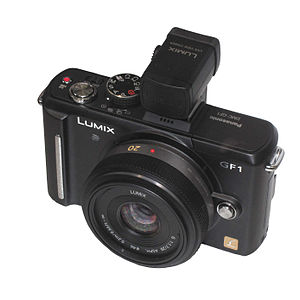Panasonic Lumix DMC-GF1
 The Panasonic DMC-GF1 (shown with the Panasonic Lumix 20mm lens and the optional electronic viewfinder) | |
| Overview | |
|---|---|
| Type | Micro Four Thirds system |
| Lens | |
| Lens | Micro Four Thirds system mount |
| Sensor/medium | |
| Sensor | 4/3 type MOS ('Live MOS sensor') |
| Maximum resolution | 4000×3000 (12.0 megapixels) |
| Storage media | SD /SDHC /MMC |
| Focusing | |
| Focus modes | Auto Focus,
Manual focus, Face Detection, AF Tracking, 23-Area-Focusing/1 Area Focusing, Single or Continuous AF, AF detection range: EV 0–18 (f/3.5 lens, ISO 100), Pre AF (Quick AF/Continuous AF), AF+MF, MF Assist(5x, 10x) |
| Exposure/metering | |
| Exposure modes | Program AE, Aperture priority AE,
Shutter priority AE, Manual, iAuto, SCN, Movie, Custom (2) |
| Exposure metering | 144-zone multi-pattern sensing system |
| Metering modes | Multiple-Weighted, Center-Weighted, Spot |
| Shutter | |
| Shutter speed range | 60–1/4000 sec |
| Continuous shooting | 7 RAW images, Unlimited JPEG images with a fast card |
| Viewfinder | |
| Viewfinder | Optional External Electronic Viewfinder |
| General | |
| LCD screen | 3.0" Low temperature Polycrystalline TFT LCD |
| Battery | 1250 mAh 7.2v Lithium-Ion rechargeable battery |
| Dimensions | 119 mm × 71 mm × 36.3 mm (4.69 × 2.8 × 1.43 inches) |
| Weight | Approx. 285 g (10.1 oz) (camera body), Approx. 448 g (15.8 oz)) (incl. 20 mm lens, card and battery) |
Panasonic Lumix DMC-GF1 was introduced in September 2009 as the third camera in Panasonic's Lumix G-series, using the Micro Four Thirds system. It was the first model in the "GF" line, which is primarily distinguished from the other Lumix G cameras by the lack of an integrated electronic viewfinder.
Features
[edit]The design of the DMC-GF1 is similar to that of the Olympus E-P1 which was introduced a few months earlier. The GF1 is 35% smaller than earlier G models. It has the same 12.1 megapixel sensor as the DMC-G1, 1280 × 720 HD recording in AVCHD Lite format, an optional hot-shoe mounted electronic viewfinder, and a 3-inch LCD with 460,000 dots. It was announced at the 2009 Internationale Funkausstellung Berlin consumer electronics exhibition. This model in the Lumix range was claimed by Panasonic[1] as the world's smallest and lightest system digital camera with a built-in flash capability.
Although the GF1 is small it still offers many advanced features such as its high definition video recording capability. It offers most of the features of the larger G1, including high speed contrast detect autofocus and an identical sensor.
Successor model
[edit]The GF1's successor, the Panasonic Lumix DMC-GF2 was announced in November 2010. The GF line has since been extended with the Panasonic Lumix DMC-GF3 (announced in June 2011), the Panasonic Lumix DMC-GF5 (announced in April 2012) and the Panasonic Lumix DMC-GF6 (announced in April 2013). Many enthusiasts decried the move away from the GF1's button driven interface and the omission of the top control dial in the GF2 and subsequent models. Because of this some feel that the Panasonic Lumix DMC-GX1 is the GF1's "spiritual successor".[2]
References
[edit]- ^ "DMC GF1". Panasonic.net. Retrieved 3 June 2010.
- ^ Diallo, Amadou. "Panasonic Lumix DMC-GX1 Review". Digital Photography Review. Archived from the original on 23 May 2012. Retrieved 18 May 2012.
External links
[edit]![]() Media related to Panasonic Lumix DMC-GF1 at Wikimedia Commons
Media related to Panasonic Lumix DMC-GF1 at Wikimedia Commons
- Panasonic Lumix DMC-GF1 Product Page
- Panasonic Lumix DMC-GF1 Product Page from Wayback Machine
- Panasonic Lumix DMC-GF1 Press Release
- Accessories compatible with the Panasonic Lumix DMC-GF1
- Panasonic Lumix DMC-GF1 Photos
- Rumored Micro Four Thirds Panasonic GF1 gets pictured
- Panasonic unveils DMC-GF1 Micro four-thirds camera
- Panasonic Lumix GF1 Review at Dpreview
- Hands On with Panasonic's Tiny SLR
- The Vimeo Panasonic DMC-GF1 Group Archived 3 November 2010 at the Wayback Machine
- Time Lapse Video with the Panasonic DMC-GF1[dead link]
